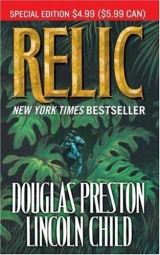
Текст книги "Relic"
Автор книги: Lincoln Child
Соавторы: Douglas Preston
Жанр:
Триллеры
сообщить о нарушении
Текущая страница: 16 (всего у книги 27 страниц)
She continued her inspection. One plant caught her eye: it had a long fibrous stem, with a single round leaf at the top. Margo realized it was some kind of aquatic plant, similar to a lily pad. Probably lived in an area of floods, she thought.
Then she realized that the incised disk found in the but showed the very same plant. She looked at the disk more closely: it depicted people harvesting these very plants from the swamp in a ceremony of sorts. The faces on the figures were twisted, full of sorrow. Very strange. But she felt satisfied to have made the connection; it might make a nice little paper for the Journal of Ethnobotany.
Putting the disk aside, she reassembled the press and screwed it down tight. A loud beeping sounded: the centrifuge was finished, the material prepared.
She opened the centrifuge and slid a glass rod into the thin layer of material at the bottom of the test tube. She carefully applied it to the waiting gel, then eased the gel tray into the electrophoresis machine. Her finger moved to the power switch. Now for another half-hour wait, she thought.
[271] She paused, her finger still on the switch. Her thoughts kept returning to the old woman and the mystery of Mbwun. Could she have been referring to the seed pods—the ones that resembled eggs? No, Maxwell had taken those back himself. They weren’t in Whittlesey’s crate. Was it one of the frogs or salamanders in jars, or one of the bird skins? That seemed an unlikely locus for the son of the devil himself. And it couldn’t have been the garden plants, because they were hidden in the plant press.
So what was it? Was the crazy old woman ranting about nothing?
With a sigh, Margo switched on the machine and sat back. She replaced the plant press and the incised disk in her carryall, brushing away a few packing fibers clinging to the press, packing fibers from the crate. There were additional traces inside her handbag. Yet another reason to clean the damn thing out.
The packing fibers.
Curious, she picked one up with the tweezers, laid it on a slide, and placed it under the stereo-zoom. It was long and irregular, like the fibrous vein of a tough-stemmed plant. Perhaps it had been pounded flat by Kothoga women for household uses. Through the microscope, she could see the individual cells gleaming dully, their nuclei brighter than the surrounding ectoplasm.
She thought back to Whittlesey’s journal. Hadn’t Whittlesey mentioned specimen jars being broken, and his need to repack the crate? So, in the area of the deserted hut, they must have thrown out the old packing material, which had become soaked in formaldehyde, and repacked the crate with material found lying near the abandoned hut. Fibers prepared by the Kothoga, perhaps; probably for weaving into coarse cloth or for the production of rope.
Could the fibers have been what the woman was referring to? It seemed impossible. And yet, Margo [272] couldn’t help a little professional curiosity about it. Had the Kothoga actually cultivated the plant?
She plucked out a few fibers and dropped them in another mortar, added a few drops of enzyme, and ground them up. If she sequenced the DNA, she could use Kawakita’s program to at least identify the plant’s genus or family.
Soon, the centrifuged DNA from the fibers was ready for the electrophoresis machine. She followed her usual procedure, then switched on the current. Slowly, the dark bands began forming along the electrified gel.
A half hour later, the red light on the electrophoresis machine winked out. Margo removed the gel tray and began recording the position of the dots and bands of migrated nucleotides, typing her results into the computer.
She punched in the last position, instructed Kawakita’s program to search for matches with known organisms, directed the output to the printer, and waited. Finally, the pages began scrolling out.
At the top of the first sheet, the computer had printed:
Species: Unknown. 10% randomized genetic matches with known species.
Genus: Unknown
Family: Unknown
Order: Unknown
Class: Unknown
Phylum: Unknown
Kingdom: Unknown
Cripes, Margo! What did you put in here? I don’t even know if this is an animal or plant. And you won’t believe how much CPU time it took to figure that out!
Margo had to smile. So this was how Kawakita’s sophisticated experiment in artificial intelligence communicated with the outside world. And the results were ridiculous. Kingdom unknown? The damn program couldn’t even tell if it were a plant or an animal. Margo suddenly felt she knew why Kawakita had been reluctant to show her the program in the first place, why it took a call from Frock to get things in motion. Once you strayed out of its known provinces, the program grew flaky.
She scanned the printout. The computer had identified very few genes from the specimen. There were the usual ones common to almost all life: a few respiration cycle proteins, cytochrome Z, various other universal genes. And there were also some genes linked to cellulose, chlorophylls, and sugars, which Margo knew were specific plant genes.
At the waiting prompt, she typed:
How come you don’t even know if it is an animal or plant? I see lots of plant genes in here.
There was a pause.
Didn’t you notice the animal genes in there, too? Run the data through GenLab.
Good point, thought Margo. She dialed up GenLab on the modem and soon the familiar blue logo popped up on the screen. She uploaded the DNA data from the fibers and ran it against their botanical sub-bank. Same results: almost nothing. A few matches with common sugars and chlorophylls.
On an impulse she ran the DNA data through the entire databank.
There was a long pause, and then a flood of information filled the screen. Margo quickly hit a series of [274] keys, instructing the terminal to capture the data. There were numerous matches with a variety of genes she had never heard of.
Logging off GenLab, she fed the data she’d captured into Kawakita’s program, instructing it to tell her what proteins the genes coded for.
A complicated list of the specific proteins created by each gene started to scroll down the screen.
Glycotetraglycine collagenoid
Suckno’s thyrotropic hormone, 2,6 adenosine [gram positive]
1,2,3, oxytocin 4-monoxytocin supressin hormone
2,4 diglyceride diethylglobulin ring-alanine
Gammaglobulin A, x-y, left positive
Hypothalamic corticotropic hormone, left negative
1-1-1 sulphagen (2,3 murine) connective keratinoid, III-IV involution
Hexagonal ambyloid reovirus protein coat
Reverse transcriptase enzyme
The list went on and on. A lot of these seem to be hormones, she thought. But what kind of hormones?
She located a copy of Encyclopedia of Biochemistrythat was busily gathering dust on a shelf, dragged it down and looked up glycotetraglycine collagenoid:
A protein common to most vertebrate life. It is the protein that bonds muscle tissue to cartilage.
She flipped through to Suckno’s thyrotropic hormone.
A hypothalamic hormone present in mammals which acts on the pituitary gland.
A terrible thought began to form inside her head. She looked up the next, 1,2,3 oxytocin 4-monoxytocin supressin hormone:
A hormone secreted by the human hypothalamus gland. Its function is not clearly understood. Recent studies have shown that it might regulate levels of testosterone in the bloodstream during periods of high stress. (Bouchard, 1992; Dennison, 1991).
Margo sat back with a start, the book dropping to the floor with a hollow thud. As she picked up the phone, she glanced at the clock. It was three-thirty.
= 38 =
When the Buick’s driver had pulled away, Pendergast mounted the steps to a Museum side entrance, juggling two long cardboard tubes beneath one arm as he showed his identification to the waiting security guard.
At the temporary command post, he shut the door to his office and extracted several yellowed blueprints from the tubes, which he spread across his desk.
For the next hour, he remained nearly motionless, head resting on tented hands, studying. Occasionally he jotted a few words in a notebook, or referred to typewritten sheets that lay on one corner of the desk.
Suddenly, he stood up. He took a final look at the curling blueprints, and slowly ran his finger from one point to another, pursing his lips. Then he gathered up most of the sheets, returned them carefully to the cardboard tubes, and stowed them in his coat closet. The rest he folded carefully and placed in a two-handled cloth bag that lay open on his desk. Opening a drawer, he removed a double-action Colt .45 Anaconda, narrow and [277] long and evil-looking. The weapon fit snugly into the holster under his left arm: not exactly standard FBI issue, but a comforting companion nonetheless. A handful of ammunition went into his pocket. From the drawer he also removed a large, bulky yellow object, which he placed in the cloth bag. Then, smoothing his black suit and straightening his tie, he slipped his notebook into the breast pocket of his jacket, picked up the cloth bag, and left his office.
New York City had a short memory for violence, and in the vast public spaces of the Museum streams of visitors could be seen once again. Groups of children crowded around exhibits, pressing noses against the glass, pointing and laughing. Parents hovered nearby, maps and cameras in hand. Tour guides walked along, reciting litanies; guards stood warily in doorways. Through it all, Pendergast glided unnoticed.
He walked slowly into the Hall of the Heavens. Potted palms lined two sides of the enormous room, and a small army of workers made last-minute preparations. The speaking platform on the podium was being sound-checked by two technicians, and imitation native fetishes were being placed on a hundred white linen tablecloths. A hum of activity floated up past the Corinthian columns into the vast circular dome.
Pendergast checked his watch: four o’clock precisely. All the agents would be at Coffey’s briefing. He walked briskly across the Hall toward the sealed entrance of Superstition. A few brief words were exchanged, and a uniformed officer on duty unlocked the door.
Several minutes later, Pendergast emerged from the exhibition. He stood for a moment, thinking. Then he walked back across the Hall and out into the corridors beyond.
Pendergast moved into the quieter backwaters of the Museum, out of the public spaces. Now he was in the storage areas and laboratories where no tourist was permitted. The high ceilings and vast decorative galleries gave way to drab cinder-block corridors lined with [278] cabinets. Steam pipes rumbled and hissed overhead. Pendergast stopped once at the top of a metal staircase, to look around for a moment, consult his notebook, and load his weapon. Then he moved downward into the narrow labyrinths of the Museum’s dark heart.
= 39 =
The door to the lab banged open, then eased back slowly. Margo looked up to see Frock backing himself inside, his wheelchair creaking. She quickly stood up and helped wheel him over to the computer terminal. She noticed he was already dressed in his tuxedo. Probably put it on before he came to work, she thought. The usual Gucci handkerchief protruded from his breast pocket.
“I can’t understand why they put these labs in such out-of-the-way places,” he grumbled. “Now what’s the great mystery, Margo? And why did I have to come down to hear it? Tonight’s foolishness is getting underway shortly, and my presence will be required on the dais. It’s a hollow honor, of course—it’s only due to my best-selling status. Ian Cuthbert made that abundantly clear in my office this morning.” His voice again sounded bitter, resigned.
Quickly, she explained how she had analyzed the fibers from the packing crate. She showed him the incised [280] disk with its harvest scene. She described the discovery and contents of Whittlesey’s journal and letter, and the talk with Jörgensen. And she mentioned how the hysterical old woman described in Whittlesey’s journal could not have been referring to the figurine when she warned the scientist about Mbwun.
Frock listened, gently turning the stone disk over in his hands. “It’s an interesting story,” he said. “But why the urgency? Chances are your sample just got contaminated. And for all we know, that old woman was insane, or Whittlesey’s recollections just got a bit scrambled.”
“That’s what I thought originally. But look at this,” Margo said, handing Frock the printout.
He scanned it quickly. “Curious,” he said. “But I don’t think that this ...”
His voice trailed off as his pudgy fingers ran down the columns of proteins.
“Margo,” he said, looking up. “I was far too hasty. It iscontamination of sorts, but not from a human being.”
“What do you mean?” Margo asked.
“See this hexagonal ambyloid reovirus protein? This is the protein from the shell of a virus that infects animals and plants. Look at how much of it there is in here. And you have reverse transcriptase, an enzyme almost always found in association with viruses.”
“I’m not sure I understand.”
Frock turned to her impatiently. “What you have here is a plant heavily infected with a virus. Your DNA sequencer was mixing them up, coding for both. Many plants carry viruses like this. A bit of DNA or RNA in a protein coat. They infect the plant, take over some of its cells, then they insert their genetic material into the plant’s genes. The plant genes start producing more viruses, instead of what they’re supposed to produce. The oak-gall virus makes those brown balls you see on oak leaves, but otherwise it’s harmless. Burls on maple and [281] pine trees are also caused by viruses. They’re just as common in plants as they are in animals.”
“I know, Dr. Frock, but—”
“There issomething in here I don’t understand,” he said, laying down the printout. “A virus normally codes for other viruses. Why would a virus code for all these human and animal proteins? Look at all these. Most of them are hormones. What good are human hormones in a plant?”
“That’s what I wanted to tell you,” Margo said. “I looked up some of the hormones. A lot of them seem to be from the human hypothalamus gland.”
Frock’s head jerked as if he had been slapped. “Hypothalamus?” His eyes were suddenly alive.
“That’s right.”
“And the creature that’s loose in this Museum is eatingthe hypothalamus of its victims! So it must need these hormones—perhaps it’s even addictedto these hormones,” Frock blurted. “Think: there are only two sources: the plants—which, thanks to this unique virus, are probably saturated with the hormones—and the human hypothalamus. When the creature can’t get the fibers, it eats the brain!”
“Jesus, how awful,” Margo breathed.
“This is stunning. It explains exactlywhat’s behind these terrible murders. With this, we can now put the pieces together. We have a creature loose in the Museum, killing people, opening the calvaria, removing the brain, and eating the thalamoid region where the hormones are most concentrated.”
He continued to look at her, his hands trembling slightly. “Cuthbert told us that he’d hunted up the crates in order to retrieve the Mbwun figurine, only to find one of the crates broken open and the fibers scattered about. In fact, now that I think of it, one of the larger crates was nearly empty of fibers. So this creature must have been eatingthe fibers for some time. Maxwell obviously used the same fibers to pack his crates. The creature may [282] not need to eat much—the hormonal concentration in the plants must be very high-but it obviously needs to eat regularly.”
Frock leaned back in the wheelchair. “Ten days ago, the crates were moved into the Secure Area, and then three days later, the two boys are killed. Another day, and a guard is killed. What has happened‘? Simple: the beast cannot getto the fibers anymore, so it kills a human being and eats its hypothalamus, thus satisfying its craving. But the hypothalamus only secretes minute amounts of these hormones, making it a poor substitute for this fiber. Based on the concentrations described in this printout, I’d hazard a guess that it would require fifty human brains to equal the concentration found in half an ounce of these plants.”
“Dr. Frock,” Margo said, “I think the Kothoga were growingthis plant. Whittlesey collected some specimens in his plant press, and the picture on this incised disk is of a plant being harvested. I’m sure these fibers are just the pounded stems from the lily pad in Whittlesey’s press—the plant depicted on this disk. And now we know: these fibersare what the woman was referring to when she screamed ‘Mbwun.’ Mbwun, son of the devil: That’s the name of this plant!”
She quickly brought the strange plant out of the press. It was dark brown and shrivelled, with a web of black veins. The leaf was thick and leathery, and the black stem as hard as a dried root. Gingerly, Margo brought her nose close to it. It smelled musky.
Frock looked at it with a mixture of fear and fascination. “Margo, that’s brilliant,” he said. “The Kothoga must have built a whole ceremonial facade around this plant, its harvest and preparation—no doubt to appease the creature. And no doubt that very beast is depicted in the figurine. But how did it get here? Why did it come?”
“I think I can guess,” Margo said, her thoughts racing. “Yesterday, the friend who helped me search the crates told me he read of a similar series of murders in [283] New Orleans several years ago. They’d occurred on a freighter coming in from Belém. My friend located the shipping records of the Museum crates, and he found that the crates were on board that ship.”
“So the creature was following the crates,” said Frock.
“And that’s why the FBI man, Pendergast, came up from Louisiana,” Margo replied.
Frock turned, his eyes burning. “Dear God. We’ve lured some terrible beast into a museum in the heart of New York City. It’s the Callisto Effect with a vengeance: a savage predator, bent on ourdestruction this time. Let’s pray there’s only one.”
“But just what kind of creature could it be?” asked Margo.
“I don’t know,” Frock answered. “Something that lived up on the tepui, eating these plants. A bizarre species, perhaps surviving since the time of the dinosaurs in tiny numbers. Or perhaps the product of a freak turn of evolution. The tepui, you see, is a highly fragile ecosystem, a biological island of unusual species surrounded by rain forest. In such places, animals and plants can develop strange parallels, strange dependencies on each other. A shared DNA pool—think of it! And then—”
Frock was silent.
“Then!”he said loudly, slapping his hand on the arm of the wheelchair. “Then they discover gold and platinum on that tepui! Isn’t that what Jörgensen told you? Shortly after the expedition fell apart, they fired the tepui, built a road, brought in heavy mining equipment. They destroyed the entire ecosystem of that tepui, and the Kothoga tribe with it. They polluted the rivers and swamps with mercury and cyanide.”
Margo nodded vigorously. “The fires burned for weeks, out of control. And the plant that sustained this creature became extinct.”
[284] “So the creature started on a journey, to follow these crates and the food it so desperately craved.”
Frock fell into silence, his head settling on his chest.
“Dr. Frock,” Margo finally said quietly. “How did the creature know the crates had gone to Belém?”
Frock looked at her and blinked. “I don’t know,” he finally said. “That’s strange, isn’t it?”
Suddenly Frock was gripping the sides of the wheelchair, rising up in his excitement. “Margo!” he said. “We canfind out exactly what this creature is. We have the means right here. The Extrapolator! We’ve got the creature’s DNA: we’ll feed it into the program and get a description.”
Margo blinked. “You mean the claw?”
“Exactly!” He wheeled around to the lab’s workstation and his fingers began moving over the keys. “I had the printout Pendergast left us scanned into the computer,” he said. “I’ll load its data into Gregory’s program right now. Help me set things up, will you?”
Margo took Frock’s place at the keyboard. In a moment, another message flashed:
ESTIMATED TIME TO COMPLETION: 55.30 minutes.
Hey, Margo, this looks like a big job. Why don’t you send out for pizza? The best place in town is Antonio’s. I recommend the green chili and pepperoni. Shall I fax them your order now?
The time was quarter past five.








